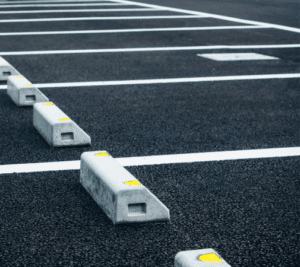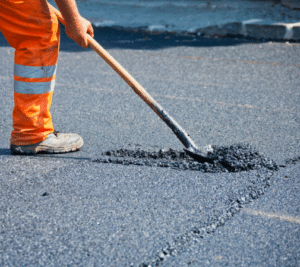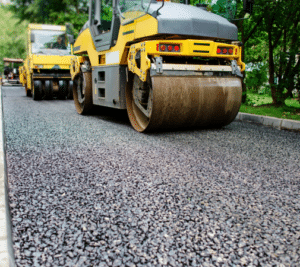If you have an asphalt surface, you want your pavement to last as long as possible. One of the ways to keep it in good shape for longer is to get a slurry seal applied to the top of it. This highly effective type of seal looks great and functions well.
What Is Slurry Seal?
When you add a slurry seal to an asphalt surface, you add a combination of asphalt emulsion, water, crushed rocks, and certain additives to the pavement. It’s similar to a fog seal, but it contains tiny crushed stones, and a fog seal doesn’t. This ingredient is known as aggregate. The seal is called a slurry because it combines the aggregate and emulsion into a mixture.
These mixtures also generally have polymers, so the mixture has even more beneficial properties. A slurry seal asphalt coating is applied to the top of the asphalt to seal the surface. They are usually applied to residential roads. If you have a long paved driveway, this type of seal can also be used on it.
What Are the Benefits of a Slurry Seal?
When a slurry seal is applied to pavement, it helps to protect the structure of the pavement and preserves it from rapid wear. It provides a new surface for driving and can also make the surface look better. When a residential road or private drive has narrow cracks and only low or moderate wear, it may be a good candidate for a slurry seal asphalt coating.
This coating can seal up any small cracks and give the asphalt flexibility. With better flexibility, it can wear better when vehicles drive on it. This type of seal also gives the pavement’s surface a deeper black color, making it look newer. It also serves to preserve the structure of the underlying pavement. It’s an excellent way to maintain a paved surface and help it last longer.
When Should a Slurry Seal Be Applied?
There is no one answer to this question. It may be applied in regular cycles, or it may be applied intermittently when it’s needed. The location of the pavement, how much traffic it gets, and the amount of weather wear it gets are all factors in getting a slurry seal. If the pavement has no rutting and little distress, it may be a good candidate for a slurry seal. If there are a lot of cracks in the pavement that aren’t very wide, it may be time to get this seal to preserve the asphalt.
When a slurry seal is applied, it can allow the pavement to last until it can be resurfaced. When resurfacing isn’t yet necessary, but there is some distress to the asphalt, using this seal is a good stop-gap measure. When this seal is applied on a cyclical basis, it generally needs to be applied about every five to seven years.
How Is Slurry Seal Applied?
The first step is mixing the aggregate and the asphalt emulsion to create the slurry. Then, it is applied by a slurry truck. These trucks are made specifically to hold the various ingredients of the slurry seal and mix them all together with a mixer. Once the slurry has been mixed, it comes out of the back of the slurry truck. It’s released onto the pavement and into a box on the back of the truck. This attached box distributes the mixture over the surface of the pavement.
Next, workers get to work spreading the seal evenly across all areas. They use squeegees to move the slurry mixture along the surface. They also ensure that the slurry doesn’t get onto any nearby concrete. The truck also drags a burlap along the pavement, making the mixture smooth out. The asphalt has a different texture from the texture of the slurry mixture. This necessitates the use of burlap to smooth the surface. This does create some faint lines on the surface of the pavement, but those will smooth out as traffic and weather affect it. After applying the slurry seal, the road should be closed to traffic for about six hours to allow it to harden.
When Should It First Be Applied?
Many studies have been done on when slurry seal asphalt coating should be applied to the pavement when it’s new. It should be applied three years after construction to get the best results and a good return for the slurry seal cost. The return on the slurry seal cost comes from the extension of the life of the pavement so that it doesn’t have to be resurfaced.
Does the Weather Make a Difference?
Yes, the weather must be good when applying the slurry seal. If it’s raining, the water will get into the mixture and dilute it. It would also make it much harder for the slurry seal to dry and harden. If it rains on the day your slurry seal is to be applied, your application will need to be postponed to a dry day.
How Long Can a Slurry Seal Last?
While five to seven years is a standard benchmark for getting a slurry seal, it may last as long as nine years if it doesn’t get much wear from traffic and weather.
What Will Happen Once the Road is Opened?
After at least six hours of hardening, the pavement will be ready to take on traffic. The road may collect some small rocks on the street’s edges for a while. This happens because some of the crushed stones won’t stick to the surface and will gather on the edges. As the road gets more wear, the loose rocks will lessen.
When you want to extend the life of your asphalt, a slurry seal is excellent for many roads that don’t have deep wear. It can fill in cracks and provide a smoother, darker surface to drive on. If you’re in the Tuscon area and think this process can be beneficial for your surface, give Saguaro Asphalt a call! Our team has the expertise to make your asphalt look new again.



